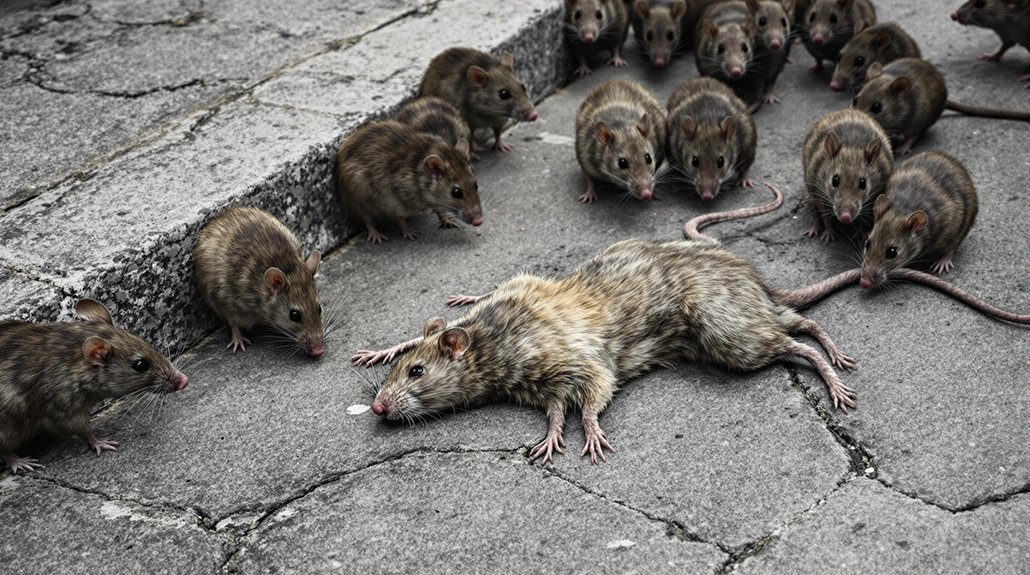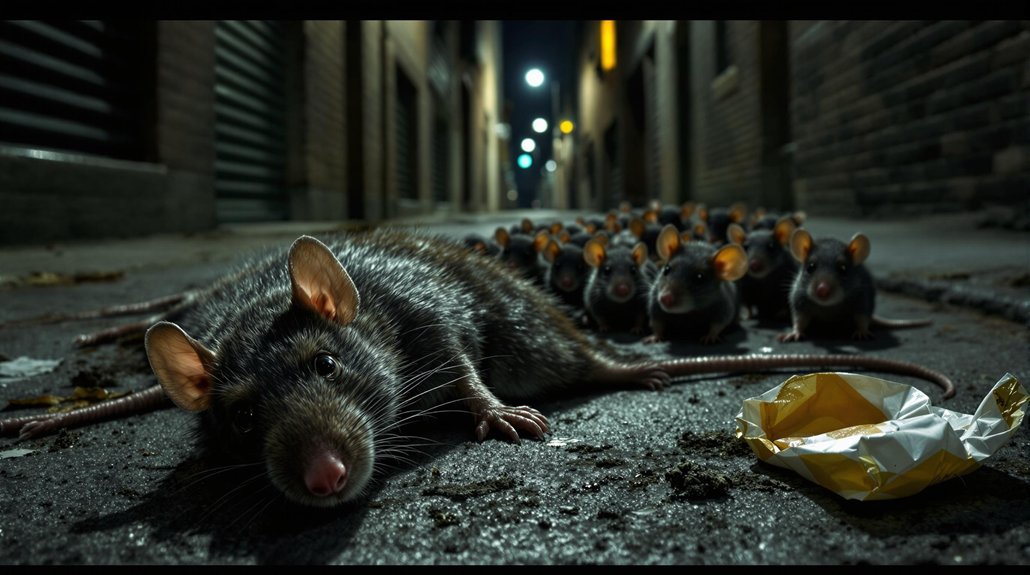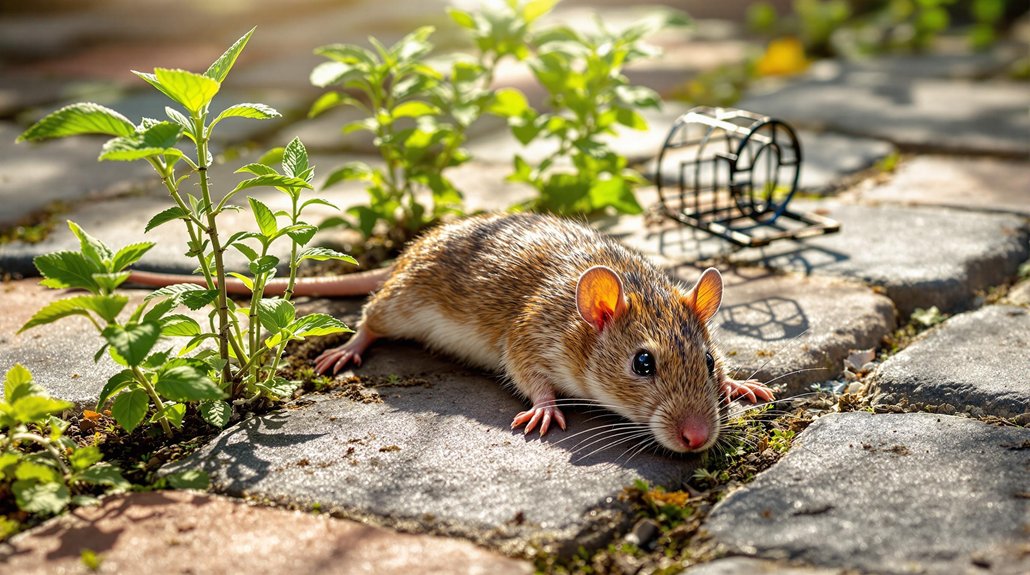Critter Wranglers, LLC Blog
Have an issue? Contact us today

Will a Dead Rat Deter Other Rats?
A dead rat can deter other rats. The presence of a dead rat triggers fear responses in nearby rats. They may see it as a warning signal, prompting them to avoid areas associated with danger. Rats communicate through scent, and a dead rat can indicate a threat. This behavior is part of their complex social structure, where avoidance can protect their group. However, dead rats can also attract scavengers, leading to additional health concerns. Understanding these dynamics is essential for effective pest management. There are other strategies to contemplate for maintaining a rat-free environment, which are worth exploring.
Key Article Highlights
- The sight of a dead rat triggers heightened fear responses in other rats, signaling potential danger in the area.
- Dead rats serve as warning signals, prompting avoidance behavior from nearby rats to ensure their safety.
- Scent marking from a dead rat may deter others by indicating territory occupancy and potential threats.
- However, the presence of dead rats can attract scavengers, potentially complicating pest management efforts.
- Removal of dead rats is essential for effective population management and to prevent future infestations in the area.
Rat Behavior and Social Structure

Although rats are often viewed as pests, they possess complex social structures and behaviors that are essential for their survival. Their group dynamics play an important role in how they interact with one another. Rats live in groups, which helps them find food and protect against predators. Within these groups, there is a social hierarchy. This hierarchy determines the roles of each rat, such as leaders and followers. Higher-ranking rats often have better access to resources. Understanding these social structures can help us manage rat populations more effectively. Recognizing their behaviors and interactions can lead to more humane solutions for dealing with them. To summarize, rat behavior and social structure are critical to their success as a species.
The Role of Scent Marking
Scent marking plays an essential role in a rat's territorial behavior. Rats use scents to mark their territory and communicate with others, establishing boundaries. This behavior can also trigger fear and avoidance in other rats, influencing their movements and interactions.
Natural Territory Markers
Many animals, including rats, rely on scent marking to establish their territory. This behavior is essential for defining territorial boundaries. Rats use scent communication to signal to others that an area is occupied. They leave their scent by urinating or through glands in their skin. This marking informs other rats of their presence and helps prevent conflicts. The scent carries information about the individual, such as gender and reproductive status. When a rat encounters these scent markers, it understands that the area belongs to another. This natural communication method helps maintain peace among rats and reduces the chances of direct confrontations. Fundamentally, scent marking plays an important role in the social structure of rat communities.
Fear and Avoidance Behavior
How do rats respond to potential threats in their environment? Rats exhibit fear conditioning as they learn to associate certain scents with danger. When a rat encounters a dead rat, it may pick up on the scent and feel fear. This response leads to avoidance learning, where rats remember to steer clear of areas marked by the scent of death. The presence of a dead rat acts as a warning signal. Other rats recognize that these scents indicate potential danger, prompting them to avoid those spaces. This behavior helps them survive by staying away from threats. Fundamentally, scent marking plays an essential role in how rats navigate their environment and guarantee their safety.
Dead Rats and Fear Responses

When confronted with the sight of a dead rat, other rats may exhibit heightened fear responses. This reaction can be understood through the lens of social dynamics among rats. When one rat sees a deceased companion, it may sense danger in its environment. This fear response is essential for survival, as it signals the presence of potential threats. Rats are social animals, and their behavior can influence one another. A dead rat can serve as a warning to others, prompting them to avoid certain areas. This instinctive behavior highlights the importance of fear as a social tool. By understanding these responses, we can better appreciate how rats navigate their surroundings and protect themselves in the wild.
Scientific Studies on Rat Behavior
Scientific studies on rat behavior reveal important insights into how they respond to threats. Research shows that rats are aware of predators and can change their behavior based on these fears. Additionally, they use territorial marking and social learning to communicate and adapt to their environment.
Fear of Predators
Why do rats exhibit specific behaviors in response to potential threats? Rats have a strong instinct for predator recognition. This ability helps them identify danger quickly. When they sense a predator, they display fear responses, which include freezing, fleeing, or hiding. These behaviors are essential for survival. Scientific studies show that rats can learn from experiences and recognize the signs of predators over time. For example, they may react more strongly to scents or sounds associated with danger. Social learning also plays a role; younger rats observe older ones and adapt their behaviors accordingly. Understanding these fear responses can help us better manage rat populations and improve methods for controlling them in various environments.
Territorial Marking Behavior
Although rats are often perceived as pests, their behaviors, particularly territorial marking, reveal complex social structures. Territorial marking is an essential part of how rats communicate. They use scent communication to establish and defend their territory. Marks left by urine or secretions inform other rats about the presence of a resident. This behavior can lead to territorial disputes, especially when a newcomer enters an established area. The scent signals help avoid direct confrontations by conveying information about the resident's identity and strength. Understanding these behaviors can help in managing rat populations effectively. By recognizing the significance of territorial marking, we can develop humane strategies to coexist with these animals while minimizing conflicts in shared environments.
Social Learning Mechanisms
Rats are not only skilled at marking their territory but also exhibit advanced social learning mechanisms. Their ability to learn from others highlights their social cognition. Observational learning allows rats to adapt to their environment effectively.
Here is a simple table showcasing key aspects of social learning in rats:
| Aspect | Description |
|---|---|
| Social Cognition | Understanding social cues from others |
| Observational Learning | Learning by watching other rats |
| Mimicry | Imitating behavior of peers |
| Problem Solving | Finding solutions through shared knowledge |
| Communication | Sharing information about dangers |
These mechanisms help rats thrive in complex social settings. Understanding these behaviors can help us develop better methods for managing rat populations.
Alternatives to Dead Rat Deterrence

While the presence of a dead rat may seem like a deterrent for other rats, there are more effective alternatives to manage rodent populations. One option is to use natural repellents, which can deter rats without harming them. These may include essential oils, such as peppermint or citronella, that create an unpleasant environment for rodents. Additionally, ultrasonic devices can help keep rats away by emitting high-frequency sounds that are uncomfortable for them, yet inaudible to humans. These alternatives are safer and more humane compared to using a dead rat as a warning. By employing these methods, we can create a healthier space for everyone while effectively reducing the presence of rats.
Effective Rat Control Methods
Implementing effective rat control methods is essential for maintaining a healthy environment. Here are four methods that can help manage rat populations:
- Effective trapping: Use snap traps or live traps to catch rats quickly and humanely.
- Chemical repellents: Apply natural or commercial repellents to deter rats from entering your space.
- Sanitation: Keep areas clean and free of food waste. Rats are less likely to thrive in tidy environments.
- Seal entry points: Inspect and block holes or cracks where rats can enter. This can greatly reduce their access to your home.
Summary of Key Takeaways

Effective rat control methods are essential for managing rodent populations. Understanding urban rodent challenges is key to implementing effective solutions. Here are some key takeaways on rat repellent strategies:
| Strategy | Effectiveness | Best Use |
|---|---|---|
| Live Traps | High | Small areas |
| Natural Repellents | Moderate | Gardens & yards |
| Ultrasonic Devices | Variable | Indoor spaces |
| Poison Baits | High | Infested areas |
| Sanitation Practices | Essential | All environments |
Frequently Asked Questions
How Long Does a Dead Rat Deter Other Rats?
The presence of a dead rat symbolizes danger, impacting rat behavior markedly. For several days, the scent marking from a deceased rat may deter other rats, as they instinctively avoid potential threats in their environment.
Can a Dead Rat Attract Other Pests?
A dead rat can indeed attract other pests, such as insects and scavengers. Effective pest control strategies should prioritize proper disposal to prevent the attraction of additional unwanted animals and maintain a hygienic environment.
What Should I Do With a Dead Rat?
What should you do with a dead rat? Effective disposing methods include sealing it in a bag for garbage collection or contacting a professional for rat removal. Proper disposal guarantees cleanliness and helps prevent further infestations.
Are There Humane Alternatives to Dead Rat Deterrence?
Humane alternatives to dead rat deterrence include using humane traps to capture and relocate rats safely. Additionally, natural repellents such as peppermint oil can deter rats without harming them, promoting a compassionate approach to pest management.
How Can I Tell if Rats Are Nearby?
To determine if rats are nearby, look for signs of life and death. Rat droppings identification and rat nest locations are key indicators. These clues reveal their presence, guiding effective action for humane deterrence.
